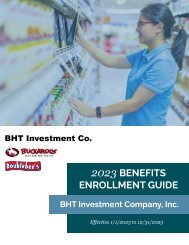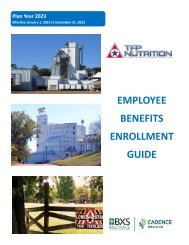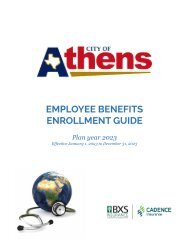Providence Engineering - 2023 Benefits Guide
Create successful ePaper yourself
Turn your PDF publications into a flip-book with our unique Google optimized e-Paper software.
GLOSSARY<br />
Coinsurance: Your share of the cost of a covered health care service, calculated as a percent (for example, 20%)<br />
of the allowed amount for the service, typically after you meet your deductible. For instance, if your plan’s<br />
allowed amount for an office visit is $100 and you’ve met your deductible (but haven’t yet met your<br />
out-of-pocket maximum), your coinsurance payment of 20% would be $20. Your plan sponsor or employer<br />
would pay the rest of the allowed amount.<br />
Copay: The fixed amount, as determined by your insurance plan, you pay for health care services received.<br />
Deductible: The amount you owe for medical services before your medical insurance or plan sponsor<br />
(employer) begins to pay its portion. For example, if your deductible is $3,000, your plan does not pay anything<br />
until you’ve met your $3,000 deductible for covered health care services. This deductible may not apply to all<br />
services, including preventive care. Preventive care is 100% covered by the plan.<br />
Employee Contribution: The weekly amount you pay for your insurance coverage.<br />
Explanation of <strong>Benefits</strong> (EOB) / Personal Health Statement (PHS): A statement sent by your insurance carrier<br />
that explains which procedures and services were provided, how much they cost, what portion of the claim was<br />
paid by the plan, and what portion is your liability, in addition to how you can appeal the insurer’s decision.<br />
These statements are also posted on the carrier’s website for your review.<br />
Flexible Spending Accounts (FSA): An option that allows participants to set aside pre-tax dollars to pay for<br />
certain qualified expenses during a specific time period (usually a 12-month period).<br />
Health Care Cost Transparency: Also known as Market Transparency or Medical Transparency. Health care<br />
provider costs can vary widely, even within the same geographic area. To make it easier for you to get the most<br />
cost-effective health care products and services, online cost transparency tools, which are typically available<br />
through health insurance carriers, allow you to search an extensive national database to compare costs for<br />
everything from prescription drugs and office visits to MRIs and major surgeries.<br />
Health Savings Account (HSA): A personal health care bank account funded by you or your employer’s tax-free<br />
dollars to pay for qualified Medical expenses. You must be enrolled in a HDHP to open an HSA. Funds<br />
contributed to an HSA roll over from year to year and the account is portable, meaning if you change jobs, your<br />
account goes with you.<br />
High Deductible Health Plan (HDHP): Plan option that provides choice, flexibility and control when it comes to<br />
spending money on health care. Preventive care is covered at 100% with in-network providers, there are no<br />
copays, and all qualified employee-paid Medical expenses count toward your deductible and your out-of-pocket<br />
maximum.<br />
In-Network: In-network providers are doctors, hospitals and other providers that contract with your insurance<br />
company to provide health care services at discounted rates.<br />
Out-of-Network: Out-of-network providers are doctors, hospitals and other providers that are not contracted<br />
with your insurance company. If you choose an out-of-network doctor, services will not be provided at a<br />
discounted rate and your cost sharing (deductibles and coinsurance) will increase.<br />
Out-of-Pocket Maximum: The maximum amount of money you will pay for medical services during the plan<br />
year. The out-of-pocket maximum is the sum of your deductible and coinsurance payments.<br />
41
















